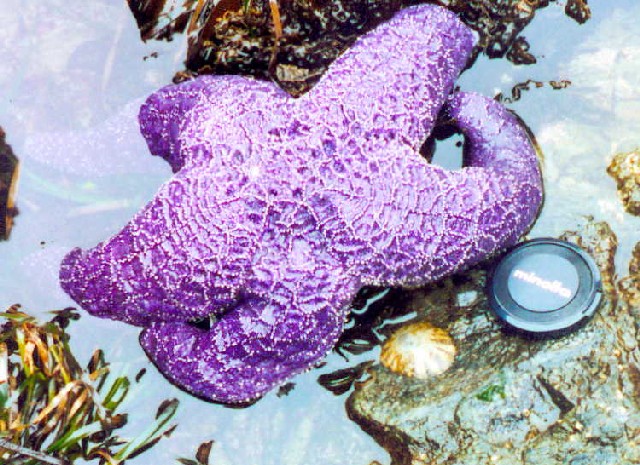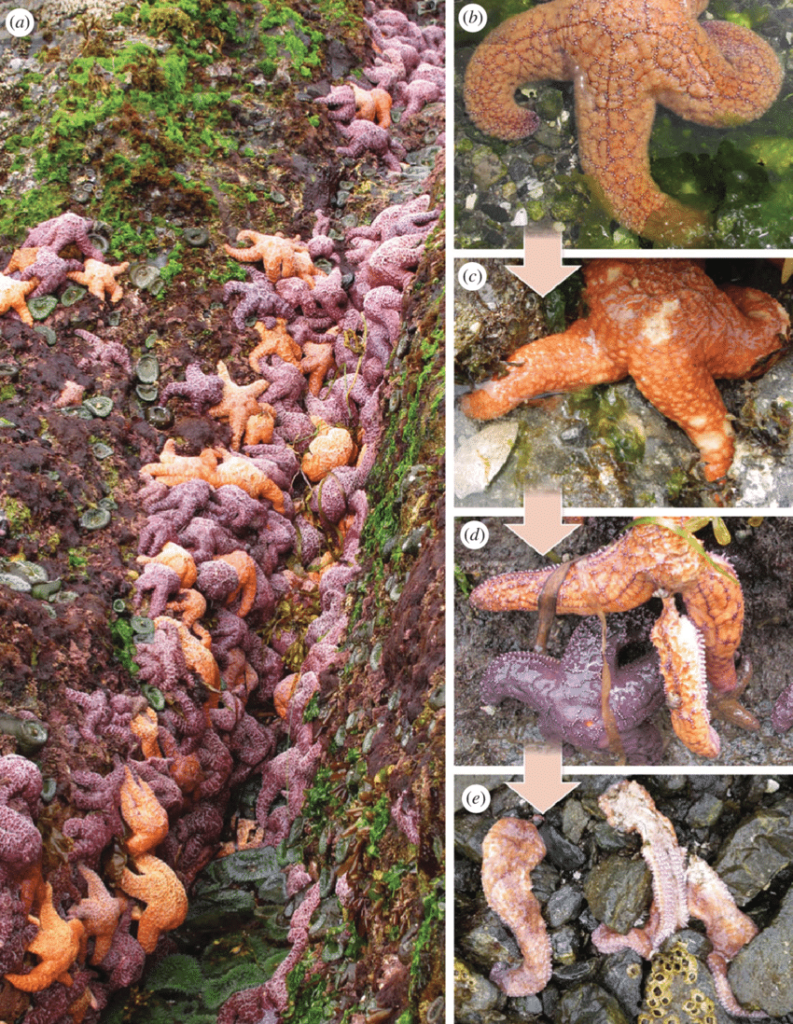Background – My wife and I are two weeks into our six-week kayak trip around the Salish Sea during the summer of 2020. These events occur just south of Washington Park in Anacortes, WA along the rocks to the west of the Skyline Marina.
We caught the northward flood as it gently pulled us around the rocky headland. Smooth black metamorphic rock from the forest of Douglas-fir down to the water’s edge where it was often split by deep fissures worn by wind and waves. The shoreline was capped by a mossy understory at the feet of the ancient trees, but as it approached the sea, it gave way to encrusting lichens, and then small, pimply barnacles and eventually clusters of the blue mussels that require near constant moisture as they bathe in the salty brine. With barely a breeze on the water, and favorable currents underneath us, we took our time and explored the cavernous fissures along the water’s edge. Most were only five to six feet tall and only a few feet deep, but for an intertidal invertebrate – living in the space between high and low tide – these crannies comprised worlds unto themselves.
Just under the surface, aggregating anemone packed themselves by the dozen into cracks, their muddy, green bases glued to the substrate and wedged together like bunches of flowers (anemone means flower in Latin.) They waved their short, pinkish tentacles in the passing current, hoping to capture a drifting bit of detritus or maybe an unlucky copepod. Acorn barnacles, like one-inch-tall erupting volcanoes poxed the outer, more wave-exposed areas of the headland. At this low tide, all the barnacles were all closed, their stony traps shut tight waiting for the waters to rise so their feeding appendages might emerge to sift for meals out of the briny soup. And of course, there were mussels, dark blue – almost black – an inch or two long and growing in tight clumps, their iron-like byssal threads securing them to the rock, protecting them from the ever-present surge and swell, threatening to pry them from their perch.
Behind one clump of mussels, barely a foot above the water, clung a five-legged, purple sea star (Pisaster ochraceus), its back etched with white dots, like constellations in the winter sky. It measured only six inches across, but its presence instantly brought joy.
I shouted to Giovannina, “Pisaster!”
Leaning back in the kayak so she could see around me, I pointed to the lonely sea star with my paddle blade.
““That’s a good sign!” Giovannina paddled close to get a better look, and then added,
“Let’s hope we see more.”
And we did. We spotted maybe a dozen or so during the three-mile paddle to Washington Park. But the presence of these Pisasters (which come in both purple and orange forms) was a welcome relief after several years of death and gruesome dismemberment almost drove them to extinction.
Sea stars – or as some folks call them, starfish – are a diverse group of utterly bizarre invertebrates that live exclusively in the ocean. They have no brain and yet can move and hunt as adeptly as a spider. Many of them, like the Pisasters we saw that day, live along rocky shorelines and adhere to the substrate using hundreds of suction cup-tipped appendages known as tube feet. Their preferred food source is bivalve mollusks, which is why they’re often found near mussel beds. In order to consume their prey, they clamp on to the shells of the mussel with their tube feet, and then pull apart the two halves just enough to – I’m not making this up – slip their stomachs out of their mouths and into the mussel where they digest the mollusk’s soft flesh before slurping it back through their mouths. What a horrendous way to die. And that isn’t their only method for gaining sustenance. On their backs, they have rows of small, beak-like structures that eat any tiny organism so unlucky to land on them (these are the white dots that we spied on the back of the purple sea star.) In addition to their fascinating methods of ingestion, they also have phenomenal powers of regeneration. A single arm and about a fifth of their oral disc are enough to grow a whole new individual. You couldn’t dream up a better science fiction monster.
And not only are these monsters fascinating in their biology, but they also play an outsized role in the ecosystems in which they dwell. In the 1960s, research by University of Washington marine biologist, Bob Payne, showed that these Pisaster sea stars act as “keystone predators” in the intertidal ecosystem. Working on Tatoosh Island off Washington’s remote Olympic coast, Payne conducted many experiments to see what impact these sea stars had on the intertidal environment. What he found became a cornerstone of modern ecology. In areas where the sea stars had been removed, the mussels would carpet the rocks, muscling out – sorry, I couldn’t resist – all other species. Because the mussels grew so well on the rocks, there was no room for barnacles, sponges, seaweeds or any other species to thrive. In essence, it became a sea of mussels. But even just a couple voracious Pisaster sea stars were enough to keep the mussels from taking over all of the rock habitat. Thus, Payne referred to the sea stars as keystone predators because, like the keystone of an arch that keeps the whole thing from collapsing in on itself, these sea stars kept the food web in balance and allowed for a diversity of species to flourish. And so, when we travel to the coast to explore the wonderful diversity of creatures found in the rocky intertidal, it is due, in no small part, to the efforts of these Pisaster sea stars.

Another sea star, the much larger, sunflower sea star (Pycnopodia helianthoides) plays a similar role in the sub-tidal environment (the area below the lowest tide, which is never exposed to the air). With dozens of arms, and measuring up to three feet across, Pycnopodia are the largest of all sea stars. They’re also the fastest – they can travel up to a three feet a minute, which isn’t cheetah speed, but when you’re hunting clams, there really isn’t a need to hurry. In addition to mollusks, sunflower sea stars also have a fondness for sea urchins, which, if not kept in check, will devour entire kelp forests. These kelp forests are home to a myriad of animals including abalone, kelp crab and many species of fish. When the sea urchins take over, they turn a rich underwater habitat into a barren patch of kelp stumps (these are often referred to as urchin barrens and are as depressing and lifeless as they sound.)
In early September of 2013, a very strange thing began happening to sunflower sea stars along the British Columbia coast. Several different people began reporting individual sunflower stars literally dissolving to death. It would usually start with a twisting of one arm, but within a couple of days it would spread to the rest of the animal. Body parts would deflate, then disintegrate and eventually fall off, turning the whole creature to mush within about seventy-two hours. At first, the problem seemed to be isolated to a few areas of British Columbia and Puget Sound, but then other reports of the same mystery illness began coming in from California. And it wasn’t just the Pycnopodia that were dying. Over ten different species of sea stars were afflicted, some worse than others. The sunflower star seemed to be particularly susceptible, with some populations being completely wiped out. Pisasters were also hit hard; an early SCUBA survey done off Alki Beach in Seattle found half of all Pisasters in some form of distress.
By the summer of 2014, Sea Star Wasting Disease, as it had come to be known, was decimating entire populations of sea stars from Southern California to Alaska. Even previously safe locations, such as the San Juan Islands and the Oregon Coast, were now awash in dead stars. And once an individual was infected, it was almost certain to die. For a group of organisms with the super-power of regeneration, watching them waste away en masse, was mystifying.
The cause of this illness remained a mystery for a long time. The fact that it seemed to affect so many different species along a vast stretch of coastline led some to speculate that we were witnessing the fallout from the Fukushima nuclear disaster. The Fukushima nuclear power plant was destroyed by an earthquake and subsequent tsunami in March 2011, and some people thought that radiation from the crippled plant had made its way across the Pacific and was now killing the sea stars. However, long-term monitoring of radiation levels showed no significant radiation in the seawater or in fish found along the West Coast of North America. Others suspected the cause to be pollution from run off, but once the disease began showing up in remote areas of the coast, that didn’t seem to fit either.
It was through cross-country collaborations and meticulous studies performed at ultra-clean facilities, such the fish pathology facility on Marrowstone Island near Port Townsend, WA, that the culprit was finally identified. Two teams Cornell University scientists, one led by Drew Harvell, who works out of UW’s Friday Harbor Labs, and the other by Ian Hewson, found the causative agent to be a type of virus, known as a densovirus and later labeled “Sea Star Associated Densovirus.”
These sea stars had been almost completely wiped out by a viral pandemic.

